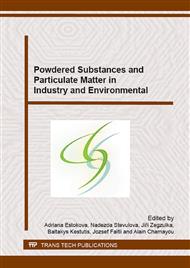[1]
P. Singh, R. Saini, A. Taneja, Physicochemical characteristics of PM2. 5: Low, middle, and high–income group homes in Agra, India–a case study, Atmos Poll Res 5 (2014) 1-9.
DOI: 10.5094/apr.2014.041
Google Scholar
[2]
C.K. Chan, X. Yao, Air pollution in mega cities in China, Atmos Enviro 42 (2008) 1–42.
Google Scholar
[3]
WHO, Air quality guidelines for Europe, World Health Organization (1987) Ser. No. 23-(1987).
Google Scholar
[4]
N.R. Ganick, R.V. Gobbell, S.M. Hays, Indoor air quality: solutions and strategies, McGraw-Hill Inc, New York, (1995).
Google Scholar
[5]
D. Massey, A. Kulshrestha, J. Masih, A. Taneja, Seasonal trends of PM10, PM5. 0, PM2. 5 & PM1. 0 in indoor and outdoor environments of residential homes located in North-Central India, Build Environ 47 (2012) 223-231.
DOI: 10.1016/j.buildenv.2011.07.018
Google Scholar
[6]
M. S Hassanvand et al., Indoor/outdoor relationships of PM10, PM2. 5, and PM1 mass concentrations and their water-soluble ions in a retirement home and a school dormitory, Atmos Environ 82 (2014) 375-382.
DOI: 10.1016/j.atmosenv.2013.10.048
Google Scholar
[7]
C.A. Pope III, D.W. Dockery, Health effects of fine particulate air pollution: lines that connect. J. Air Waste Manag. Assoc., 56 (2006) 709-742.
DOI: 10.1080/10473289.2006.10464485
Google Scholar
[8]
P. Urso, A. Cattaneo, G. Garramone, C. Peruzzo, D.M. Cavallo, P. Carrer, Identification of particulate matter determinants in residential homes, Build Environ 86 (2015) 61-69.
DOI: 10.1016/j.buildenv.2014.12.019
Google Scholar
[9]
P. Fabian, G. Adamkiewicz, J.I. Levy, Simulating indoor concentrations of NO2 and PM2. 5 in multifamily housing for use in health-based intervention modeling. Indoor Air 22(1) (2013) 12-23.
DOI: 10.1111/j.1600-0668.2011.00742.x
Google Scholar
[10]
D. Custódio, I.P. Cerqueira, T. Nunes, C. Pio, Short Communication Indoor and outdoor suspended particulate matter and associated carbonaceous species at residential homes in northwestern Portugal, Sci Total Environ 473–474 (2014) 72–76.
DOI: 10.1016/j.scitotenv.2013.12.009
Google Scholar
[11]
O. Raaschou-Nielsen, M. Sørensena, O. Hertel, B. LK. Chawes, N. Vissing, K. Bønnelykke, , H. Bisgaard, Predictors of indoor fine particulate matter in infants' bedrooms in Denmark, Environ Res 111(1) (2011) 87-93.
DOI: 10.1016/j.envres.2010.10.007
Google Scholar
[12]
A. Kumar, D. Srivastava, M. Agrawal and A. Goel, Snapshot of PM Loads Evaluated at Major Road and Railway Intersections in an Urban Locality. Int J Environ Prot 4(1) (2014) 23-29.
Google Scholar
[13]
P. Mikuška, K. Křumal, Z. Večěřa, Characterization of organic compounds in the PM2. 5 aerosols in winter in an industrial urban area, Atmos Enviro 105 (2015) 97-108.
DOI: 10.1016/j.atmosenv.2015.01.028
Google Scholar
[14]
Md. F. Khan, Y. Shirasuna, K. Hirano, S. Masunaga. Characterization of PM2. 5, PM2. 5–10 and PM>10 in ambient air, Yokohama, Japan. Atmos Res 96(1) (2010) 159-172.
DOI: 10.1016/j.atmosres.2009.12.009
Google Scholar
[15]
M. Braniš, P, Řezáčová, M. Domasová. The effect of outdoor air and indoor human activity on mass concentrations of PM10, PM2. 5, and PM1 in a classroom, Environ Res 99 (2005) 143-149.
DOI: 10.1016/j.envres.2004.12.001
Google Scholar
[16]
H. Fromme, D. Twardella, S. Dietrich, D. Heitmann, R. Schierl, B. Liebl and H. Ruden. Particulate matter in the indoor air of classrooms—exploratory results from Munich and surrounding area, Atmos Environ., 41 (2007) 854-866.
DOI: 10.1016/j.atmosenv.2006.08.053
Google Scholar
[17]
Ch. Cáceres-Araya, H. Altamirano-Medina, C. Shrubsole, Assessing the relationship between outdoor air pollution and indoor air quality in naturally ventilated classrooms: a case study from Chile, Healthy Buildings Europe 2015, 18-20 May 2015, Eindhoven, 1-9.
Google Scholar
[18]
P. Fantke et al. Health effects of fine particulate matter in life cycle impact assessment: findings from the Basel Guidance Workshop, Int J Life Cycle Assess 20 (2015) 276–288.
DOI: 10.1007/s11367-014-0822-2
Google Scholar
[19]
A.W. Gertler, J.A. Gillies, W.R. Pierson, An assessment of the mobile source contribution to PM10 and PM2. 5 in the United States, Water Air Soil Poll 123 (2000) 203–214.
DOI: 10.1007/978-94-011-4369-1_18
Google Scholar
[20]
D. Martuzevicius, S.A. Grinshpun, T. Lee, S. Hu, P. Biswas, T. Raponen, G. LeMasters, Traffic-related PM2. 5 aerosol in residential houses located near major highways: Indoor versus outdoor concentrations, Atmos Environ 42(27) (2008) 6575-6585.
DOI: 10.1016/j.atmosenv.2008.05.009
Google Scholar


